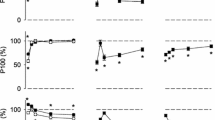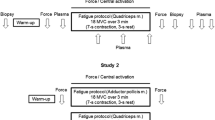Abstract
Force and relaxation were measured during electrical stimulation of the quadriceps muscle of 14 volunteers. Stimulation produced 51.2 s of intermittent ischaemic contractions either as 16 3.2-s tetani or as 64 0.8-s tetani. Changes during recovery were followed for 180 s. On 8 subjects muscle biopsies were taken during work and after the rest period for determination of ATP, phosphocreatine and intermediates in glucolysis. The stimulation using 0.8-s contractions gave more pronounced fatigue and slowing of relaxation. There was a good correlation between force and relaxation during work but this relation changed during recovery, indicating that no general relation exists between these two contraction characteristics. In the 0.8-s stimulation more ATP was utilized and there were more profound changes in metabolite levels. We found a correlation between estimated [H2PO −4 ] and relaxation covering both work and recovery and hypothesize that inorganic phosphate and its removal by phosphocreatine resynthesis during recovery might be important. Since stimulation patterns differ in force and relaxation even after the recovery period we suggest that additional factors, such as pH, are of importance in this work model.
Similar content being viewed by others
References
Bergström J (1962) Muscle electrolytes in man. Determination by neutron activation analysis in needle biopsy specimens. A study on normal subjects, kidney patients, and patients with chronic diarrhoea. Scand J Clin Lab Invest [Suppl] 68:1–110
Bergström M, Hultman E (1986) Relaxation time during intermittent isometric contraction in subjects with different capacity for oxidative work. Acta Physiol Scand 127:107–110
Bergström M, Hultman E (1988) Energy cost and fatigue during intermittent electrical stimulation of human skeletal muscle. J Appl Physiol 65:1500–1505
Bigland-Ritchie B (1981) EMG and fatigue of human voluntary and stimulated contractions. Ciba Found Symp 82:130–156
Blanchard EM, Pan B-S, Solaro RJ (1984) The effect of acid pH on the ATPase activity and troponin Ca2+ binding of rabbit skeletal myofilaments. J Biol Chem 259:3181–3186
Cady EB, Elshove H, Jones DA, Moll A (1989a) The metabolic causes of slow relaxation in fatigued human skeletal muscle. J Physiol (Lond) 418:327–337
Cady EB, Jones DA, Lynn J, Newham DJ (1989b) Changes in force and intracellular metabolites during fatigue of human skeletal muscle. J Physiol (Lond) 418:311–325
Chasiotis D (1983) The regulation of glycogen phosphorylase and glycogen breakdown in human skeletal muscle. Acta Physiol Scand [Suppl] 518:1–68
Chasiotis D, Bergström M, Hultman E (1987) ATP utilization and force during intermittent and continuous muscle contractions. J Appl Physiol 63:167–174
Cooke R, Franks K, Luciani GB, Pate E (1988) The inhibition of rabbit skeletal muscle contraction by hydrogen ions and phosphate. J Physiol (Lond) 395:77–97
Cresshull I, Dawson MJ, Edwards RHT, Gadian DG, Gordon RE, Radda GK, Shaw D, Wilkie DR (1981) Human muscle analysed by 31P nuclear magnetic resonance in intact subjects. J Physiol (Lond) 317:18P
Dawson MJ, Gadian DG, Wilkie DR (1980) Mechanical relaxation rate and metabolism studied in fatiguing muscle by phosphorus nuclear magnetic resonance. J Physiol (Lond) 299:465–484
Dawson MJ, Smith S, Wilkie DR (1986) The [H2PO −4 ] may determine cross-bridge cycling rate and force reduction in living fatiguing muscle. Biophys J 49:268a
Donaldson SKB, Hermansen L (1978) Differential, direct effects of H+ on Ca2+-activated force of skinned fibers from the soleus, cardiac and adductor magnus muscles of rabbits. Pflügers Arch 376:55–65
Duchateau J, Hainaut K (1985) Electrical and mechanical failures during sustained and intermittent contractions in humans. J Appl Physiol 58:942–947
Duchateau J, de Montigny L, Hainaut K (1987) Electromechanical failures and lactate production during fatigue. Eur J Appl Physiol 56:287–291
Edwards RHT, Hill DK, Jones DA (1975) Metabolic changes associated with the slowing of relaxation in fatigued mouse muscle. J Physiol (Lond) 251:287–301
Edwards RHT, Hill DK, Jones DA, Merton PA (1977) Fatigue of long duration in human skeletal muscle after exercise. J Physiol (Lond) 272:769–778
Fabiato A, Fabiato F (1978) Effects of pH on the myofilaments and the sarcoplasmic reticulum of skinned cells from cardiac and skeletal muscles. J Physiol (Lond) 276:233–255
Fitts RH, Holloszy JO (1978) Effects of fatigue and recovery on contractile properties of frog muscle. J Appl Physiol 45:899–902
Harris RC, Hultman E, Nordesjö L-O (1974) Glycogen, glycolytic intermediates and high-energy phosphates determined in biopsy samples of musculus quadriceps femoris of man at rest. Methods and variance of values. Scand J Clin Lab Invest 33:109–120
Harris RC, Hultman E, Kaijser L, Nordesjö L-O (1975) The effect of circulatory occlusion on isometric exercise capacity and energy metabolism of the quadriceps muscle in man. Scand J Clin Lab Invest 35:87–95
Harris RC, Edwards RHT, Hultman E, Nordesjö L-O, Nylind B (1976) The time course of phosphorylcreatine resynthesis during recovery of the quadriceps muscle in man. Pflügers Arch 367:137–142
Hultman E, Sahlin K (1980) Acid base balance during exercise. Exerc Sports Sci Rev 8:41–128
Hultman E, Sjöholm H, Sahlin K, Edström L (1981) Glycolytic and oxidative energy metabolism and contraction characteristics of intact human muscle. Ciba Found Symp 82:19–40
Hultman E, Chasiotis D, Sjöholm H (1983a) Energy metabolism in muscle. In: Sutton JR, Houston CS, Jones NL (eds) Hypoxia, exercise, and altidude: Proc 3rd Banff Int Hypoxia Symp. Liss, New York, pp 257–272
Hultman E, Sjöholm H, Jäderholm-Ek I, Krynicki J (1983b) Evaluation of methods for electrical stimulation of human skeletal muscle in situ. Pflügers Arch 398:139–141
Miller RG, Giannini D, Milner-Brown HS, Layzer RB, Koretsky AP, Hooper D, Weiner MW (1987) Effects of fatiguing exercise on high-energy phosphates, force, and EMG: evidence for three phases of recovery. Muscle Nerve 10:810–821
Miller RG, Boska MD, Moussavi RS, Carson PJ, Weiner MW (1988) 31P nuclear magnetic resonance studies of high energy phosphates and pH in human muscle fatigue. J Clin Invest 81:1190–1196
Nakamura Y, Schwartz A (1971) The influence of hydrogen ion concentration on calcium binding and release by skeletal muscle sarcoplasmic reticulum. J Gen Physiol 59:22–32
Ren JM, Hultman E (1989) Regulation of glycogenolysis in human skeletal muscle. J Appl Physiol 67:2243–2248
Sjöholm H, Sahlin K, Edström L, Hultman E (1983) Quantitative estimation of anaerobic and oxidative energy metabolism and contraction characteristics in intact human skeletal muscle in response to electrical stimulation. Clin Physiol 3:227–239
Snedecor GW, Cochran WG (1967) Statistical methods (6th edn). Iowa State Univ Press, Ames
Söderlund K, Hultman E (1986) Effects of delayed freezing on content of phosphagens in human skeletal muscle biopsy samples. J Appl Physiol 61:832–835
Spriet LL, Söderlund K, Bergström M, Hultman E (1987) Skeletal muscle glycogenolysis, glycolysis and pH during electrical stimulation in men. J Appl Physiol 62:616–621
Wilson JR, McCully KK, Mancini DM, Boden B, Chance B (1988) Relationship of muscular fatigue to pH and diprotonated Pi in humans: a 31P-NMR study. J Appl Physiol 64:2333–2339
Author information
Authors and Affiliations
Rights and permissions
About this article
Cite this article
Bergström, M., Hultman, E. Relaxation and force during fatigue and recovery of the human quadriceps muscle: relations to metabolite changes. Pflügers Archiv 418, 153–160 (1991). https://doi.org/10.1007/BF00370464
Received:
Revised:
Accepted:
Issue Date:
DOI: https://doi.org/10.1007/BF00370464




